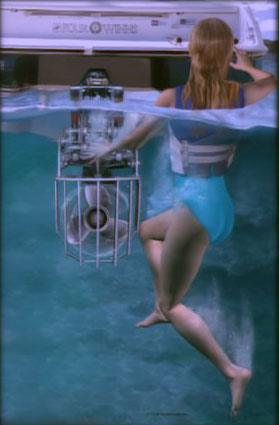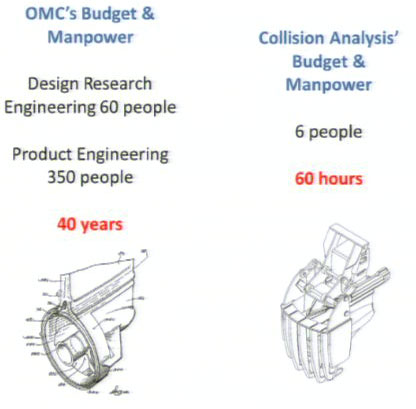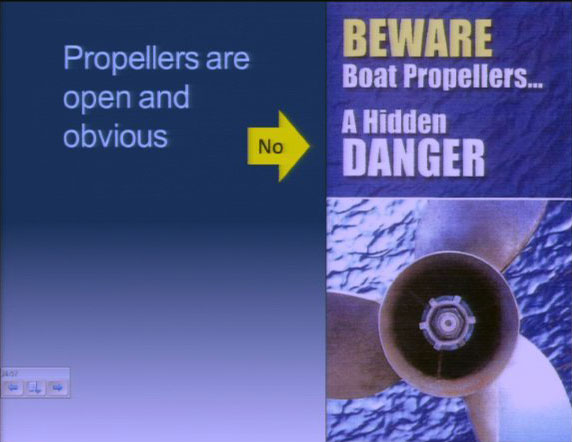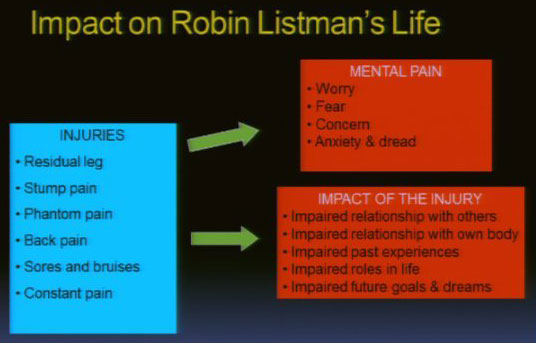Listman vs OMC trial 1 November Session 1A – Plaintiff Opening Statements
This post is part of our coverage of the Listman v. OMC propeller injury trial
Robin Listman vs. Outboard Marine Corporation
Second Judicial District Court of the State of Nevada, County of Washoe
1 November 2011 Session One – pm (Note there was no morning session, this was an afternoon session per CVN)
Our coverage was obtained via a video feed supplied by Courtroom View Network (CVN). The images are also courtesy of CVN.
This part of the session was the Plaintiff’s Opening Statement.
We heard from one attorney:
- Bill Jeanney for Listman
Bill Jeanney tells us the defective design is the unguarded propeller.
Boat was first sold in 1994 as a 1995 model.
In 1994, they had stats available for the last 25 years, as early as 1978 showing 40 to 45 deaths by propellers per year.
We will hear the typical propeller accident happens at low speeds.
He pointed out a 3 blade prop turning at 700 RPM (a slow speed) can still inflict 36 impacts per second. Designers in 1994 /95 had the information we just talked about, but they still put the ladder and swim platform by the propeller.
Both sides agree to these statements:
- A spinning propeller is dangerous
- People can slip or fall in
- Driver can’t see people in the water at the rear
- A guard would make it safer
- There should be a guard if one works (meets criteria)
OMC had the knowledge, resources, ability, and budget to do it (create a guard).
Don Kueny is here. He was Chief Design Engineer at OMC in 1975 and later.
In Kueny’s 37 years at OMC they never had a specific engineering project to develop a propeller guard.
OMC sold the Gale propeller guard in the 1970’s and a portion of the 1980’s. Fishermen were having problems with propeller damage, so OMC built it to protect the propellers. The Gale guard box says it was not designed to protect swimmers.
OMC Australia developed the surf rescue guard and told the head of OMC what a good job it did. It surrounded the prop and had a mesh cover. It protects people with great results.
OMC Project 441 was started in 1978. They built and tested a guard, were not thrilled with its performance (impact on speeds), and terminated the project. However, they did patent it.
OMC Project 443 was started in 1980. This propeller guard broke / fractured during their testing. Recommendations were that further research and development, and better materials might make it work. Project 443 was terminated.
Craig Good (Dr. Good) developed a propeller guard for the plaintiff’s legal team. Dr. Good runs a business called Collision Analysis in Canada. He has five people there. Together, they developed the guard in 60 hours. It protects people to the side and rear of the propeller, and retracts at speeds in excess of 12 miles per hour. The retractable guard built by Dr. Good is referred to as the Listman Propeller Guard.The boat’s performance is not impacted beyond the criteria set by the defendant.
The jury will be shown video of the testing of the Listman propeller guard.
At this time he showed some brief testing videos produced by the defense team of boat test runs.
You will hear from Dr. Arthur Reed, a Naval Architect and Marine Engineer. Dr. Reed has been with the Navy from 1974 to present working on boat propulsion systems for his whole career. Dr. Reed will tell you that engineers must do a hazard analysis of designs. If they identify a hazard they must design it out or guard against it.
OMC did not build a propeller guard in with 40 years and lots of resources. Dr. Good built one with six people in 60 hours.
Jeanney used a fan again as an example of a propeller that needs guarded (he did that at least once earlier too).OMC’s defense will be:
- U.S. Coast Guard and the Government did not require it
- Nobody else does
- Props are open and obvious
- Don’t meet OMC’s performance requirement
- Entrapment
- Listman jumped in
He then began to briefly address each of OMC’s defenses.
When he started talking about “Props are open and obvious” my mind flipped to the USCG propeller danger flyer that says “Hidden Danger” on it. Just then he showed a graphic of the flyer. That was cool.
As he continued to discuss the Open and Obvious defense, he noted some people don’t intend to get in the water, they get rocked off the boat, etc. It doesn’t matter if it the prop was obvious to them or not, its too late.
We previously noted a change in the Open and Obvious propeller defense by the boating industry. (See pages 70-71 of our study of the withdrawal of the USCG Houseboat Propeller Safety Proposed Rules). There we point out how they used to use to Open and Obvious defense. However, now they put propeller safety decals on the boats and ABYC’s industry standard says warning labels are only supposed to be used if:
- The hazard is associated with the use of the equipment
- The manufacturer knows of the hazard
- The hazard is not obvious or readily discoverable by the user
- The hazard will exist during normal use or foreseeable misuse
At time it seems like every other word the industry says in a prop trial is “standard”. “With no standards, we just don’t know what to do”. Well they have a standard here, they are using prop warning labels (there were some on this boat) so it (1) must be a hazard, (2) they know about it, (3) the hazard is not obvious, and (4) the hazard exists during normal use or foreseeable misuse.
I would like to see them discuss those points sometime in court. The decals are made available by NMMA and are even required to be used as part of NMMA’s boat certification program. They can’t have it both ways.
OMC’s Propeller Guard Performance Criteria is they want boats to perform within ten percent of unguarded boats in these variables:
- Top speed
- Fuel economy
- Acceleration
- Draft
- Handling / steering
- Maneuvering – at high and low speeds
- Durability – won’t break
- Hold straight line
- Cavitation
- Handle weeds
Jeanney thinks the Listman Propeller Guard meets the criteria.
The jury will get to hear a couple days of propeller guard testing reports from Robert Taylor (expert for the defense) and Craig Good.
Jeanney showed some defense video of boat test runs in which the defense said the boat was behaving erratically and lurching with the guard, but nothing out of the ordinary was visible in the video. He also showed one in which the defense said they boat performance degraded in reverse, but nothing looked out of the ordinary.
While Dr. Good worked in the Navy, Robert Taylor (expert for the defense) has spent the last 25 years as a defense expert for the boating industry. He is always testifying for OMC, Mercury Marine, or other boating industry companies. We will discuss what kind of money he has made while doing that and if that might shade his testimony.
Entrapment is raised against propeller guards. What are the percentages of being entrapped vs. being cut by an open propeller. We will ask Kelly Kennett (defense expert) if he would rather fall on an unguarded propeller or a guarded propeller.
While discussing where everybody was seated leading up to the accident Jeanney showed a boat seating chart that included an image of dinosaur float toy that blew off the beach they were trying to retrieve at the time of the accident. He said it was three to four feet tall when being towed on the water.We wonder when somebody is ever going to ask them how many people get entrapped in an open propeller. We are constantly reading propeller accident reports in which the person was entrapped by the propeller or impaled on it. We listed several of these accidents on a page titled Entrapped by a Boat Propeller. Once again, the industry wants it both ways. They say you should not use guards because they entrap people, but countless more people have been entrapped on open propellers than on guards. We are aware of many more open propeller entrappments not on that list.
You will hear from David Lloyd who tried to grab the toy.
There was no alcohol involved, no drugs, no foolishness involved in this accident.
That makes it a lot tougher on the defense team.
The float toy blew to the stern, Robin was crouched on the swim platform, she knows of the propellers, she did not intent to assume any risk of getting near any propeller, a gust of wind rocked the boat, she fell in. It all happened in just a few seconds. He showed a picture of the swim platform ladder area and explained where her feet were.
Although he showed the image and discussed the location of her feet, we were unable to understand exactly where they were. It would have been nice is someone was standing in that position in the image.
Robin’s leg had a near transection of her right lower extremity. Basically they had to take off her lower right leg. Jeanney showed some artistic renditions of her injuries. (We elected not to display them here).
He spoke about the importance of being able to leave enough of the limb above or below the knee to put a prosthesis on.
Listman will tell you that as soon as she hit the water, she tried to right herself, is being sucked into the prop, and boom – prop hits her and blood all over in the water.
They took her from the water and told her not to look at her leg, they knew she lost a lot of blood and might not make it. They were met by a chopper. She was fuzzy at the hospital, then woke up about two days later to find her lower right leg gone.
Prior to the accident she led a very active life, had a job, took care of her kids, was a wife, and took care of her house.
She was very courageous and left the hospital just 5 days later. Her mom came to take care of her for a while, then told her should would have to take care of herself on her own less than 30 days after the amputation. Her husband was working full time during this period.
Jeanney went on to discuss the pain and problems related to getting your stump / residual limb ready to accept a prosthesis. Lots of swelling and pain issues. Fit issues are a continual problem once you get one. She had to undergo physical therapy to learn to walk again. Her current medical costs to date are $220,754.36.
Later we will hear from Richard Riley, a certified prosthetist who will talk about some of the problems and will project the life costs of her prosthetics.
We will also hear from Gilbert Coleman PhD an economist. He will show that her future cost just for prosthetics for the next 40 years will be $1,269,299 (yes, that is about $1.27 million).
We will hear how the prosthetic has impacted Robin Listman’s life.Robin currently wears a prosthetic with a computer in the knee like those worn by veterans from Iraq and Afghanistan. She has back pain on the side her prosthetic is on and knee pain on the other side.
This case is about the defect in the design that makes it unreasonably dangerous. The spinning propeller is unreasonably dangerous. A guard should have been developed, retractable like the one we built. Given the resources of OMC they should have been able to build this guard in months.
Was OMC’s design reasonable, or was it dangerous vs. a guard?





